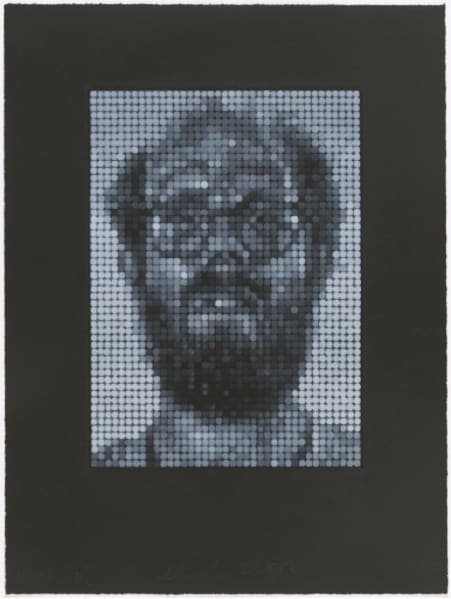Chuck Close American, 1940-2021
Self Portrait, White on Black, 1997
Spitbite Etching
20.5 x 15.75"
201609-2282
Visualisation
Chuck Close is celebrated for his monumental portrait paintings in which sitters stare out at viewers with uncompromising gazes. Although identified by name, these subjects reveal none of the nuances...
Chuck Close is celebrated for his monumental portrait paintings in which sitters stare out at viewers with uncompromising gazes. Although identified by name, these subjects reveal none of the nuances of individual personality found in traditional portraiture. Instead, Close focused on his working procedures—the "means" rather than the "ends" usually associated with this genre.
It is the visual effects of translating a photograph into a painting that Close exploited in endless permutations. Translating still further into printmaking offered even more variables to stimulate his creativity. He completed approximately fifty-five prints, working in numerous techniques. These editions have allowed a broad audience to have access to his work, a fact that Close appreciated since his painting process is lengthy and results in relatively few canvases.
Self Portrait, Spitbite is based on the half-tone dot from most recognized from the commercial printing industry seen in newsprint. From a conceptual standpoint, the half-tone is very fascinating because not only is it purely abstract but fully representational.
Most etchings are created by placing the plate in a bath. This etching was created by applying the acid directly onto the place using a brush. Every single one of the dots is a different application of acid. The printers that worked on this with Chuck Close used a metronome to time every single dot because the longer the acid sits on the plate, the deeper the burn and the darker result. Aldo Crommelynk, Picasso's favorite printer, worked on this piece alongside Chuck, and it was actually Aldo's saliva, from his unfiltered French cigarettes, the "worked best for the process" according to the artist.
Created in 1997, this Self Portrait, Spitbite is unique in that the artist used white ink on black paper. The piece is hand-signed by Chuck Close in pencil in the lower margin and numbered from the edition of 50. It is presented archivally in a white-washed maple frame.
It is the visual effects of translating a photograph into a painting that Close exploited in endless permutations. Translating still further into printmaking offered even more variables to stimulate his creativity. He completed approximately fifty-five prints, working in numerous techniques. These editions have allowed a broad audience to have access to his work, a fact that Close appreciated since his painting process is lengthy and results in relatively few canvases.
Self Portrait, Spitbite is based on the half-tone dot from most recognized from the commercial printing industry seen in newsprint. From a conceptual standpoint, the half-tone is very fascinating because not only is it purely abstract but fully representational.
Most etchings are created by placing the plate in a bath. This etching was created by applying the acid directly onto the place using a brush. Every single one of the dots is a different application of acid. The printers that worked on this with Chuck Close used a metronome to time every single dot because the longer the acid sits on the plate, the deeper the burn and the darker result. Aldo Crommelynk, Picasso's favorite printer, worked on this piece alongside Chuck, and it was actually Aldo's saliva, from his unfiltered French cigarettes, the "worked best for the process" according to the artist.
Created in 1997, this Self Portrait, Spitbite is unique in that the artist used white ink on black paper. The piece is hand-signed by Chuck Close in pencil in the lower margin and numbered from the edition of 50. It is presented archivally in a white-washed maple frame.
Share
- X
- Tumblr
Related artworks




